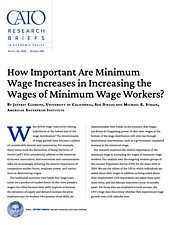What drives wage trajectories among individuals at the lowest end of the wage distribution? The determinants of wage growth have become a subject of considerable interest and controversy. For example, these issues hold the distinction of being the focus of David Card’s 2022 presidential address to the American Economic Association, and economists and commentators alike are increasingly debating the relative importance of competitive market forces, employer power, and institutions in determining wages.
The traditional economic view holds that wage trajectories are a product of market forces. In this view, people’s wages rise either because their skills improve or because the dynamics of supply and demand increase the price employers pay for workers who possess those skills. An institutionalist view holds, to the contrary, that wages are driven by bargaining power. In this view, wages at the bottom of the wage distribution will only rise through institutional interventions, such as a government-mandated increase in the minimum wage.
Our research examines the relative importance of the minimum wage in increasing the wages of minimum wage workers. Our analysis uses the outgoing rotation groups of the Current Population Survey (CPS) for the years 2010 to 2019. We use the subset of the CPS in which individuals are asked about their wages in addition to being asked about their employment. CPS respondents are asked these questions twice, and the relevant interviews occur 12 months apart. For those who are employed in both surveys, the CPS’s wage data thus reveal whether they experienced wage growth over a full calendar year.
Our analysis yields several findings of interest. Our first finding is that wage growth is the norm among minimum wage workers who persist in their employment. We define minimum wage workers in our baseline sample as individuals with wages within 50 cents of the effective minimum wage when they are first interviewed about their earnings. Among individuals in this sample, more than 70 percent of those employed 12 months later are employed at a higher wage. The wages of minimum wage workers interviewed rose on average by $1.39, and those who did see an increase on average earned an additional $2.05. The wage increases we observe, which occur over 12-month periods, suggest that a very small fraction of individuals can plausibly be described as career minimum wage workers.
Moreover, we find qualitatively similar likelihoods of wage growth among workers who live in states that increased their minimum wages and among those who do not. Around 71 percent of minimum wage workers in states that did not increase their minimum wage at any point in the 2013–2018 period got a raise in any given year, compared with around 79 percent of minimum wage workers in states that did increase their minimum wage. Wage increases for minimum wage workers is the norm in both groups of states.
Our initial finding is consistent with past work on the prevalence of minimum wage careers. Some widely cited previous studies from the late 20th century have found that just over 60 percent of minimum wage workers experienced wage growth if employed one year later. Other analyses suggest that the prevalence of wage gains among minimum wage workers has been quite stable, rising moderately from 1979 through 2002.
We next find several broad factors correlated with wage growth among individuals who were minimum wage workers at baseline. We find particularly strong correlations between wage growth and variables that describe whether an individual has changed industries or occupations. This suggests that wage growth is strongly predicted by progression in minimum wage workers’ careers. We also find correlations between wage growth and several proxies for overall macroeconomic conditions. These correlations suggest that increases in overall demand for labor generate wage gains. We find that wage growth is positively correlated with institutional variables including indicators for both the enactment of minimum wage increases and whether the individual is a member of or covered by a union. Taken together, we thus find that a broad set of factors predict wage growth, including the progression of an individual’s career, overall economic conditions, and institutional forces.
Finally, we attempt to quantify the role of minimum wage increases relative to other factors by estimating a model of the likelihood of a minimum wage worker getting a raise between CPS outgoing rotation group interviews. For workers who were employed in both outgoing rotations, we find that living in a state that increased its minimum wage between interviews is associated with a 13.8 percentage point increase in the probability of getting a raise. For the 12-month periods during which a minimum wage increase went into effect, this estimate implies a 21 percent increase in the probability of receiving a wage increase, as the baseline mean in states that never increased their minimum wages is 65.8 percent. In states that implemented a minimum wage increase at least once during our sample, minimum wage increases account for roughly 8 percent of the wage increases realized by minimum wage workers across our full sample period.
Our findings reveal that it is easy to overstate the minimum wage’s relevance as a source of low-wage workers’ wage gains. Our findings indicate that state minimum wage changes account for a modest fraction of the wage gains realized by minimum wage workers. Improvements in macroeconomic conditions and progression across occupations and industries appear to play a more significant role.
Note
This research brief is based on Jeffrey Clemens and Michael R. Strain, “How Important Are Minimum Wage Increases in Increasing the Wages of Minimum Wage Workers?,” NBER Working Paper no. 29824, March 2022.

This work is licensed under a Creative Commons Attribution-NonCommercial-ShareAlike 4.0 International License.
